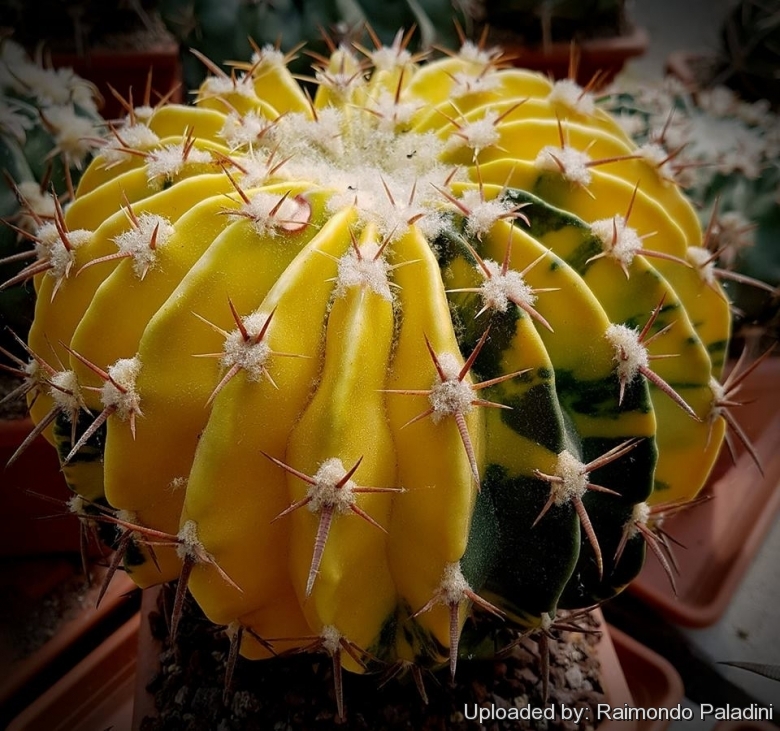




Your support is critical to our success.
Accepted Scientific Name: Homalocephala texensis (Hopffer ex Regel) Britton & Rose

Origin and Habitat: Garden origin (Nursery produced cultivar)
Synonyms:
Description: The typical Echinocactus texensisSN|2231]]SN|2231]], best known in cultivation as Homalocephala texensisSN|2230]]SN|2230]], is a stout barrel cactus that lies low to the ground, solitary when young, very rarely slowly clustering in age. It is distinguished by rather flattened, often very strong spines. They are a rich brown and form a pleasing contrast against the grey green body.
Variegated form: Variegated Echinocactus texensisSN|2231]]SN|2231]] are cultivated for their beautiful stems that have sectors, patches or stripes with two colours, yellow and green. There are several forms of variegation. The extent and nature of the variegation can vary, and sometimes the plant will return to the green form. In others it is stable and does not change under normal conditions. Flowers are produced only on the crown of mature specimens. Variegated specimens are sometime grafted on stronger species, called the stock, that can be any number of different columnar cactus.
Subspecies, varieties, forms and cultivars of plants belonging to the Echinocactus texensis group
 Echinocactus texensis Hopffer ex Regel: is a stout barrel cactus with strong annulated spines, not hiding stem surface. The centrals hooked and flattened pale tan, pink-reddish to grey. Distribution: Southern USA and northeastern Mexico.
Echinocactus texensis Hopffer ex Regel: is a stout barrel cactus with strong annulated spines, not hiding stem surface. The centrals hooked and flattened pale tan, pink-reddish to grey. Distribution: Southern USA and northeastern Mexico. Echinocactus texensis f. cristata hort.: crested form. Its stems fan out and can get very big making a spectacular specimen.
Echinocactus texensis f. cristata hort.: crested form. Its stems fan out and can get very big making a spectacular specimen. Echinocactus texensis f. cristatus variegatus hort.: crested and variegate form.
Echinocactus texensis f. cristatus variegatus hort.: crested and variegate form. Echinocactus texensis f. variegatus hort.: variegated form: stems that have sectors, patches or stripes with two colours, yellow and green. There are several forms of variegation. The extent and nature of the variegation can vary.
Echinocactus texensis f. variegatus hort.: variegated form: stems that have sectors, patches or stripes with two colours, yellow and green. There are several forms of variegation. The extent and nature of the variegation can vary. Echinocactus texensis cv. Anayami Monstr: has many irregular, more or less prominent supplemental monstrous ribs between and on the true ribs surface with very elongated, felty areoles filled by pectinate spines.
Echinocactus texensis cv. Anayami Monstr: has many irregular, more or less prominent supplemental monstrous ribs between and on the true ribs surface with very elongated, felty areoles filled by pectinate spines. Echinocactus texensis cv. Kyoushi Anayami: has twisted spines that looks like odd spiders.
Echinocactus texensis cv. Kyoushi Anayami: has twisted spines that looks like odd spiders. Echinocactus texensis cv. Togenasi Ayanami: is a spineless form.
Echinocactus texensis cv. Togenasi Ayanami: is a spineless form.
Cultivation and Propagation: Variegated cacti are regarded as choice and difficult in cultivation, but despite that many of them are relatively easy to grow. But be aware that they cannot tolerate prolonged exposure to direct sun light (especially during the hottest summer days), so grow them in half-shade or under filtered sun. They are sometime seen as grafted plants, but some of this colourful plants (those with some chlorophyll) are able to grow on their own roots and are priced by collectors.
Soil: Use mineral well-permeable substratum with little organic matter (peat, humus).
Watering: Water sparingly from March till October, and keep perfectly dry in winter, at temperatures from 5 to 15 degrees centigrade. (In general these plants are more tender and cannot endure freezing temperatures). In the rest period no high atmospheric humidity!!
Propagation: By seeds, grafting or cutting. Because the variegation is due to the presence of two kinds of plant tissue, propagating the plant must be by a vegetative method of propagation that preserves both types of tissue in relation to each other. A most common way way to cultivate this partially de-coloured cultivars is to graft them onto another cactus which has chlorophyll and which will provide sugar to the mutant scion. The chlorophyll containing bottom part of the graft, called the stock, can be any number of different columnar cactus species.
Remarks: Seeds from variegated parents often give raise to some variegated seedlings too.
| Your Actions | |
|---|---|
| Back to Echinocactus index | |
| Back to Cactaceae index | |
 |
Back to Cacti Encyclopedia index |
Privacy stantement - Terms and conditions - How to cite - About us - Feedback - Donate



